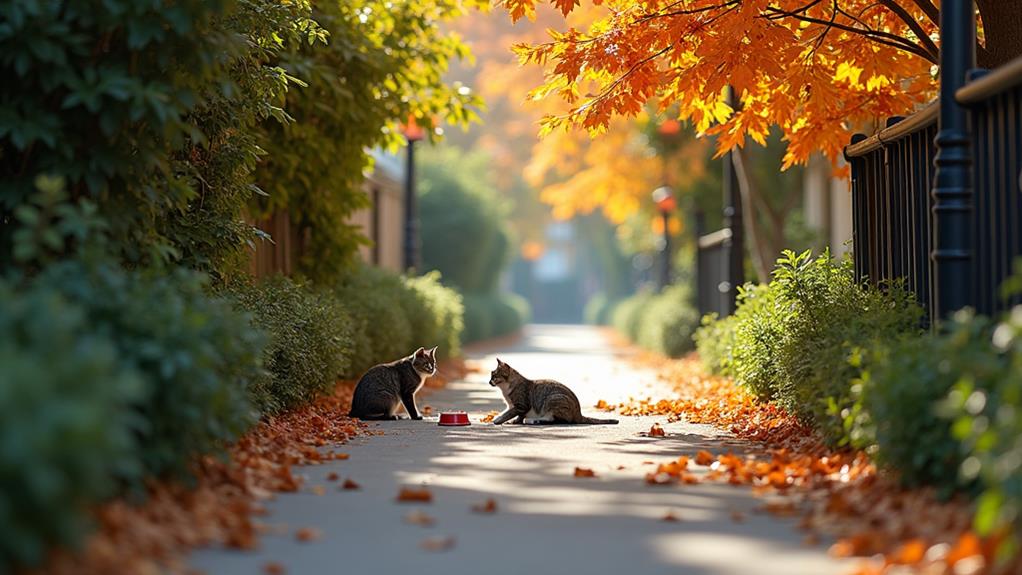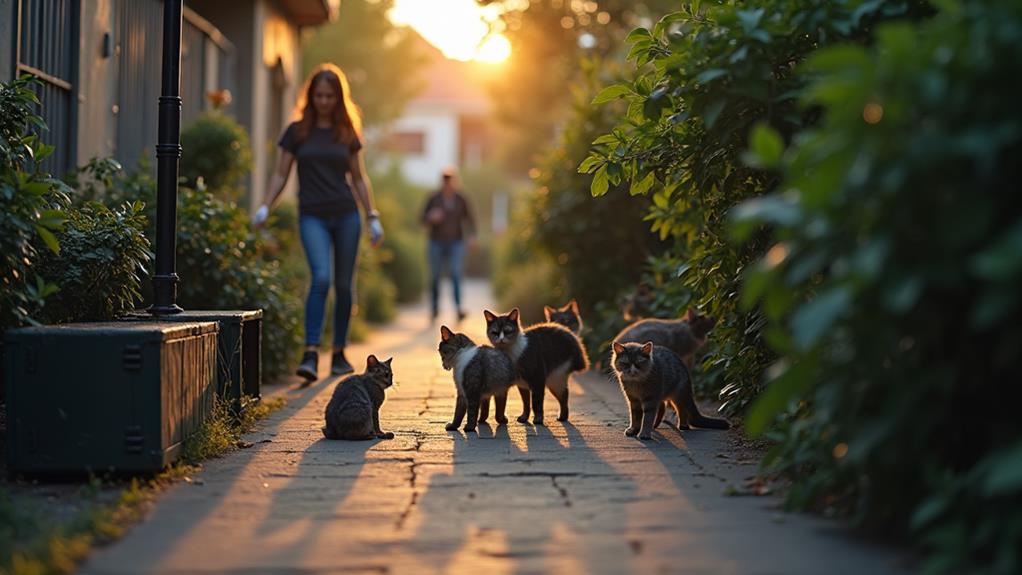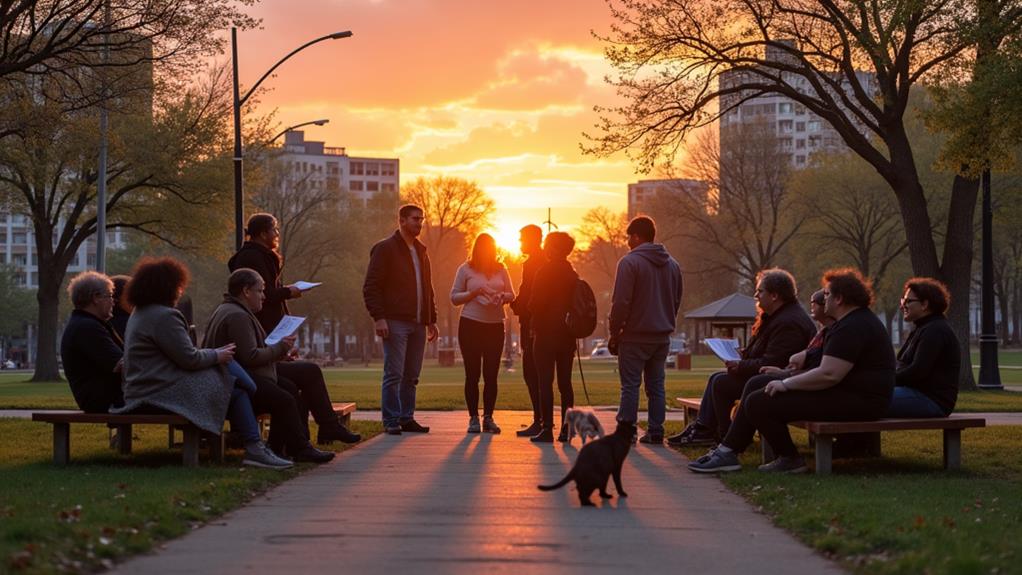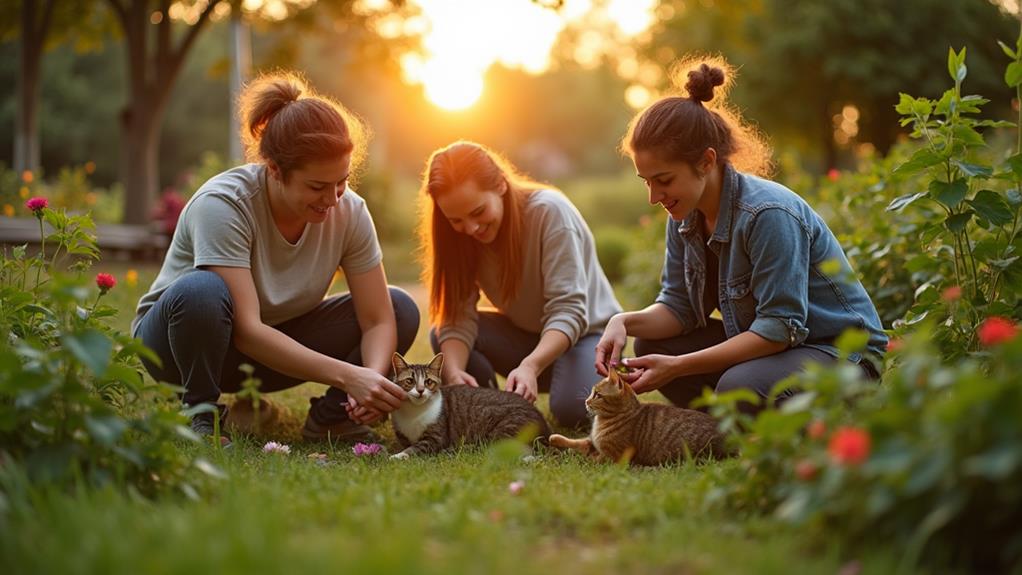National Feral Cat Day: How to Get Involved and Support Feral Cats

Celebrate National Feral Cat Day on October 16 by getting involved in efforts to protect feral cats. Start by participating in TNR (Trap-Neuter-Return) programs to manage and reduce populations. Organize or support community events like spay/neuter clinics and educational outreach to raise awareness about the importance of humane strategies. Advocate for cat-friendly policies by contacting local officials and writing to newspapers. Volunteer at shelters and donate supplies or funds to aid in their operations. Use social media to spread awareness and connect with others supporting the cause. There's much more you can do for these independent felines.
Understanding Feral Cats
When it comes to understanding feral cats, it's necessary to recognize that these are unsocialized domestic cats living in the wild, often forming colonies for survival. Unlike stray cats, which may seek your affection, feral cats shy away from human interaction and are more fearful. You might encounter them in different community cat colonies, where they've built a social structure to endure harsh conditions. Their lives are tough and short, typically just 2 to 3 years, due to environmental hazards and a lack of veterinary care.
To help manage these homeless cats, TNR programs (Trap-Neuter-Return) are significant. By participating in TNR, you can assist in the spay and neuter of feral cats, preventing the birth of countless more. A single female can produce up to 30 new feral cats each year, so intervention is crucial. Organizations like Alley Cat Allies promote awareness and support for these programs, aiming to improve the lives of feral cats and reduce their ecological impact. As you become more informed, you play an important role in supporting community cats and ensuring a balanced coexistence with local wildlife.
Importance of National Feral Cat Day
National Feral Cat Day plays an essential role in highlighting the challenges faced by feral cat populations and the significance of community involvement in addressing these issues. Celebrated on October 16, this day was established by Alley Cat Allies in 2001 to raise awareness about the plight of feral cats. With an estimated 60-100 million feral cats in the U.S., the need for attention and action is imperative. National Feral Cat Day encourages compassionate people to participate in efforts that improve the lives of community cats.
Key to this is the promotion of the Trap-Neuter-Return (TNR) initiative. TNR programs are an effective way to manage feral cat populations, improving their health and reducing the number of kittens born each year. On this day, advocacy for humane and cat-friendly policies at local and state levels is emphasized. Education and awareness campaigns are essential to fostering a better understanding of feral cats and encouraging community involvement.
Through organized TNR efforts and collaborative initiatives, National Feral Cat Day serves as a platform for individuals and organizations to share information, inspire collective action, and ultimately, make a positive impact on community cats' lives.
Participating in TNR Programs

As you consider ways to support feral cats, participating in Trap-Neuter-Return (TNR) programs offers a practical and impactful approach. TNR programs involve humanely trapping feral cats, sterilizing them, and vaccinating against diseases before returning them to their original territory. This method is known to stabilize and reduce populations over time, with some communities experiencing up to a 50% decrease in feral cats. By preventing the birth of thousands of kittens, TNR also improves the health and well-being of existing cats.
Community involvement is essential for the success of TNR initiatives. It requires ongoing support for feeding, monitoring, and maintaining the health of returned cats, ensuring a humane approach to feral cat management. Many organizations provide training resources to help you get started, making it easier for you to join or initiate TNR programs in your area.
Organizing Community Events
Although supporting feral cats might seem challenging, organizing community events can make a significant impact while bringing people together. Start by hosting spay/neuter clinics, which are fundamental in reducing feral cat populations. Often, these clinics are offered at low or no cost, making them accessible to everyone. Incorporate educational outreach by setting up informational booths and distributing pamphlets about the importance of Trap-Neuter-Return (TNR) programs. This helps raise awareness and informs the public on how they can contribute to humane treatment.
Community events can also focus on building outdoor shelters and feeding stations. These efforts provide feral cats with safe havens and improve their quality of life. Engaging with local officials during events can further promote cat-friendly policies. Advocacy plays a vital role in encouraging community members to support the humane treatment of feral cats.
Collaborate with local organizations, such as shelters and veterinarians, to amplify your reach and resources. These partnerships can improve TNR initiatives and guarantee the success of your community events. By coming together and organizing these events, you're not just supporting feral cats, but also fostering a community that values responsible care and compassion.
Advocacy and Policy Change

Building on the momentum created through community events, advocacy and policy change are key to ensuring lasting support for feral cats. You can play a crucial role in shaping future cat-friendly policies by reaching out to local lawmakers. Advocating for Trap-Neuter-Return (TNR) initiatives can effectively manage community cats while promoting humane laws.
Here are some impactful actions you can take:
- Contact local officials: Advocate for the adoption of cat-friendly policies that support TNR and humane treatment of feral cats.
- Write letters: Address the editor of your local newspaper to raise awareness about the benefits of TNR and humane laws for both community cats and residents.
- Harness social media: Share your experiences and advocacy efforts, using National Feral Cat Day hashtags to engage a wider audience.
- Partner with animal organizations: Collaborate to create campaigns that encourage community support for policy changes and cat welfare.
- Engage with lawmakers: Meet or communicate with local lawmakers to influence policy changes that protect feral cats and highlight the ecological benefits of TNR.
Supporting Cat Shelters
Supporting cat shelters is fundamental for the well-being of both feral and stray cats. By volunteering your time, you can assist with daily operations, such as socializing cats, which prepares them for potential adoption. Many shelters depend heavily on donations, so consider contributing food, litter, or supplies. Organizing collection drives in your community can also provide significant support. Financial donations are crucial, enabling shelters to offer necessary medical care and spay/neuter services, which are essential for controlling feral cat populations.
As a community member, you can play a significant role in supporting cat shelters by participating in fundraising events. These events not only raise funds but also raise awareness about the shelters' needs. Promoting adoption programs is another way to make a difference. Encouraging others to adopt from shelters reduces the number of cats needing homes and fosters the shelters' mission to find loving families for feral cats.
Public education is key in reducing the influx of stray and feral cats. Informing others about spay/neuter programs and responsible pet ownership can improve shelter efforts, ensuring a sustainable future for these vital community resources. Your involvement truly makes a difference.
Utilizing Social Media

In conjunction with supporting cat shelters, using social media can greatly improve efforts to aid feral cats. You can help raise awareness by sharing photos and stories of local community cats and TNR (trap-neuter-return) efforts. This not only educates people about the significance of feral cat care but also inspires others to get involved. Use hashtags like #NationalFeralCatDay and #TNR to connect with cat lovers and advocates worldwide, creating a larger impact than you might imagine.
Here are some ways to effectively utilize social media:
- Share Educational Content: Post about the benefits of TNR programs and why feral cat care is essential.
- Engage with Local Organizations: Like, share, and comment on posts from animal organizations to amplify their messages.
- Organize Virtual Events: Host challenges or events on Facebook or Instagram to encourage participation in feral cat advocacy.
- Highlight Success Stories: Share successful TNR cases to motivate others and highlight effective community efforts.
- Connect with Advocates: Use specific hashtags to join a community of cat lovers enthusiastic to make a difference.
Educational Outreach
A well-informed community is the cornerstone of effective feral cat management. On National Feral Cat Day, educational outreach initiatives play an essential role in teaching community members about humane strategies like Trap-Neuter-Return (TNR) to control feral cat populations. By distributing informative materials, you can raise awareness of the ecological impact feral cats have on local wildlife and biodiversity. Understanding these effects is fundamental for promoting balanced ecosystems.
Consider hosting workshops to extend your outreach. These sessions can equip attendees with practical skills, such as feeding strategies and shelter construction, ensuring feral cats receive proper care while minimizing negative impacts. Such workshops also emphasize the importance of regular health checks to maintain cat welfare.
Additionally, utilize social media platforms to share educational content and personal experiences. This approach engages a wider audience and encourages collective action toward feral cat welfare. Collaborating with local organizations to set up booths at community events can also open up discussions on responsible pet ownership. These interactions stress the necessity of spaying/neutering pets to prevent future feral populations. Through these concerted efforts, you can effectively contribute to a more informed and compassionate community.
Fostering Community Involvement

Building on the foundation of educational outreach, involving the community in direct actions can create a lasting impact on feral cat welfare. By organizing spay/neuter clinics, you can help control feral cat populations and improve their health. These events often bring together community volunteers and local organizations, fostering a spirit of collaboration and advocacy. Setting up informational booths during local events can educate the public about Trap-Neuter-Return (TNR) practices, encouraging humane treatment of feral cats.
Consider providing outdoor shelters and feeding stations. These resources engage community members and guarantee that feral cats have safe places to rest and eat. Working with local organizations amplifies your efforts, creating a stronger push for cat-friendly policies and community actions.
Don't underestimate the power of social media. Sharing your experiences and successes in feral cat care can inspire others and increase community involvement. With a few clicks, you can spread awareness and motivate others to join your efforts.
- Organize spay/neuter and vaccination clinics for population control.
- Set up informational booths to promote TNR education.
- Construct outdoor shelters and feeding stations.
- Collaborate with local organizations for effective advocacy.
- Harness social media to inspire and engage the community.




